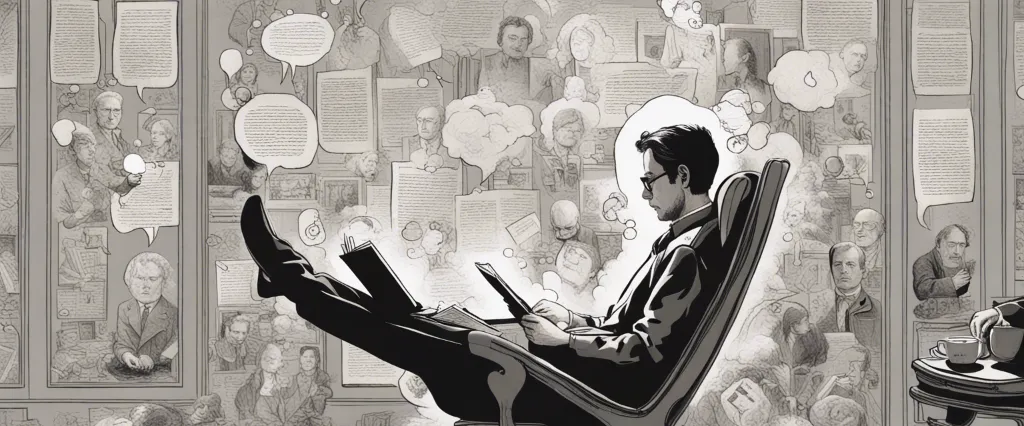
The world of literature encompasses a vast array of genres, each communicating stories that entertain, inspire, and resonate with readers. Behind every captivating narrative lies the mastery of its author, who skillfully weaves words and constructs compelling stories that leave an indelible mark on our hearts and minds. In this comparative study, we delve into the realms of two outstanding books, “Wired for Story” by Lisa Cron and “On Writing Well” by William Zinsser, to explore their unique perspectives on the art of storytelling.
Lisa Cron’s “Wired for Story” offers invaluable insights into the psychological foundations underlying the human experience of storytelling. As a seasoned story consultant and writing instructor, Cron delves deep into the realm of neuroscience to unravel the intricacies of what truly captures readers’ attention. Her work offers an engaging exploration of how stories affect us on a cognitive and emotional level, highlighting the deep-rooted intricacies ingrained within the human brain that make storytelling integral to our existence.
Contrasting Cron’s focus on the psychological mechanisms of a narrative, William Zinsser’s “On Writing Well” seeks to refine the craft of writing itself. Zinsser, a distinguished writer and editor, imparts his wisdom on the art of writing nonfiction effectively and succinctly. He masterfully guides aspiring writers through principles of clarity, simplicity, and brevity, emphasizing the importance of honing one’s craft by focusing on the essential elements of effective communication.
As we navigate through the pages of these remarkable works, our aim is to juxtapose the distinct approaches of Cron and Zinsser, exploring how they equip writers with the tools to captivate readers based on different perspectives. Through this comparative study, we aim to uncover the underlying harmonies or discrepancies between these two crucial aspects of storytelling: the profound psychological connection between readers and narratives, as highlighted by Lisa Cron, and the technical craftsmanship of prose and nonfiction writing embodied by William Zinsser.
Ultimately, in examining these two literary works side by side, we aim to gain a comprehensive understanding of the multifaceted art of crafting narratives. By intertwining the psychological allure of storytelling with the technical prowess of writing, we aspire to explore how these complementary perspectives combine to create stories that leave an indelible impact on readers.
In the following sections, we will delve into the core concepts presented in “Wired for Story” and “On Writing Well,” carefully dissecting their methodologies and exploring their broader implications for aspiring writers and storytellers alike. It is through this analysis that we hope to unveil the secrets behind the creation of compelling narratives that ensnare the minds and hearts of readers.
Brief Summary of Two Books
Wired for Story by Lisa Cron
“Wired for Story” by Lisa Cron is a book that explores the science behind storytelling and its impact on the human brain. Cron argues that humans are naturally wired to respond to stories, and understanding how this wiring works can help writers create more compelling and engaging narratives.
The book begins by delving into the evolutionary reasons why humans are drawn to stories. Cron discusses how storytelling has been a crucial aspect of human communication since the dawn of civilization and provides insights into how our brains process and remember stories.
Cron also emphasizes the importance of the brain’s need for a story to make sense and seeks meaning. She explains how the brain constantly seeks patterns and connections within narratives and discusses the role of emotions in engaging readers. Cron explores the idea that stories are not merely a form of entertainment but also a way to communicate important knowledge and stimulate empathy.
The author then delves into the elements that make a story effective, such as creating a compelling protagonist, establishing clear goals and obstacles, and crafting a well-paced plot. She provides practical advice on how to structure a story to captivate readers and keep them engaged.
Additionally, Cron emphasizes the significance of understanding the impact of a story on the reader’s emotions. She explains how to effectively evoke emotional responses through strong characterization, sensory details, and skillful use of conflict.
Throughout the book, Cron provides numerous examples from well-known novels and movies to illustrate her points and offers exercises to help writers implement her advice. She stresses the importance of knowing the target audience and understanding their desires and fears.
In summary, “Wired for Story” is a thought-provoking exploration of the neuroscience behind storytelling. It provides valuable insights for writers on how to craft compelling narratives that resonate with readers, tapping into our innate human response to storytelling.
On Writing Well by William Zinsser
“On Writing Well” by William Zinsser is a non-fiction book that serves as a guide to improve one’s writing skills across a variety of genres. Zinsser emphasizes simplicity and clarity as the key tenets of good writing, arguing that writers should strive to express ideas in a straightforward, understandable manner.
The book is divided into four major parts, with each section covering different aspects of writing. The first part focuses on principles and strategies for writing non-fiction, such as how to find a suitable topic, how to conduct research, and how to organize thoughts effectively. Zinsser emphasizes the importance of identifying the target audience and adjusting the style and tone of writing accordingly.
The second part of the book delves into various forms of non-fiction writing. Zinsser examines writing about people and places, sports, art, science, business, and technology. He provides specific advice on how to approach each subject to engage readers and convey information effectively.
Zinsser then moves on to discuss different writing styles and techniques in the third part of the book. This section covers topics such as word choice, grammar, rhythm, and the use of humor. Zinsser encourages writers to use precise language, avoid clichés, and pay attention to sentence structure to create engaging and memorable prose.
Lastly, the fourth part of the book addresses the editing and revising process. Zinsser emphasizes the importance of self-editing, offering practical advice on how to tighten sentences, eliminate unnecessary words, and ensure coherence and flow throughout the text. He also highlights the significance of receiving feedback from others and being open to constructive criticism.
Overall, “On Writing Well” provides practical advice and insightful tips for writers of all levels, inspiring them to write with clarity and simplicity and fostering a stronger connection between writer and reader.
Comparison between Two Books

Similarities in writing
In the parallel analysis of “Wired for Story” by Lisa Cron and “On Writing Well” by William Zinsser, some significant similarities between these two books on writing can be identified:
1. Emphasis on storytelling: Both books recognize the importance of storytelling in effective writing. They highlight that engaging narratives are deeply ingrained in human psychology and can captivate readers’ attention.
2. Focus on clarity and simplicity: Zinsser and Cron stress the significance of clear and concise writing. They advocate for eliminating unnecessary jargon, complex sentence structures, and excessive adjectives. Both authors assert that simplicity enhances readability and improves the communication of ideas.
3. Understanding the target audience: Zinsser and Cron emphasize the importance of knowing and connecting with the intended readership. They highlight the need for writers to understand what their audience desires, what provokes their interest, and how to effectively engage them through tailor-made content.
4. Importance of revision: Both books underscore the importance of revision in the writing process. Zinsser and Cron advise writers to revise and edit their work multiple times to improve clarity, coherence, and overall impact. They contend that even experienced writers need to continuously refine their work.
5. Integration of emotions: Zinsser and Cron discuss the influence of emotions in writing. They argue that engaging readers’ emotions is key to creating an impactful and memorable piece of writing. Both authors provide strategies for evoking emotions through vivid descriptions, relatable characters, and emotive storytelling techniques.
6. Utilization of examples and anecdotes: Zinsser and Cron utilize numerous examples and anecdotes to illustrate their points and make their ideas more relatable. They recognize the power of storytelling within a non-fiction framework to make concepts more accessible and compelling to readers.
7. Authenticity and personal voice: Both books stress the importance of maintaining authenticity and finding one’s own voice as a writer. They encourage writers to convey their thoughts and ideas genuinely, rather than trying to imitate others or conform to a particular writing style. Zinsser and Cron believe that embracing one’s individuality leads to stronger and more captivating writing.
Overall, “Wired for Story” and “On Writing Well” share common ground when it comes to the essential elements of effective writing, including storytelling, clarity, audience understanding, revision, emotional impact, use of examples, and authenticity. These parallels provide writers with valuable insights and techniques to enhance their craft and engage their readers more effectively.
Divergences in writing
Wired for Story by Lisa Cron and On Writing Well by William Zinsser are both highly regarded books that offer valuable insights into the craft of writing. While they share similarities in their ultimate goal of helping writers improve their skills, there are notable divergences in their approaches and specific focuses.
One of the key divergences between Wired for Story and On Writing Well lies in their subject matter. Lisa Cron primarily delves into the realm of storytelling and narrative, examining the cognitive aspects behind why humans are drawn to stories and how writers can use this understanding to their advantage. On the other hand, William Zinsser’s On Writing Well focuses more on the technical and practical aspects of writing nonfiction, providing guidelines for clarity, precision, and engaging prose.
Another divergence lies in the emphases placed by each author. Lisa Cron places significant weight on the role of neuroscience and psychology in crafting effective stories, exploring how the brain responds to compelling narratives. She emphasizes the importance of creating vivid, relatable characters and engaging readers on an emotional level. In contrast, William Zinsser emphasizes simplicity, conciseness, and clarity in writing nonfiction, advocating for the removal of unnecessary jargon, excessive wordiness, and inflated language.
The writing style and tone of the two books also differ. Wired for Story is written in a more conversational and engaging manner, with Cron using anecdotes and examples to illustrate her points. She often incorporates her experiences in the entertainment industry to demonstrate how storytelling techniques are utilized in various mediums. Conversely, On Writing Well has a more formal and instructional tone, with Zinsser presenting his advice in a straightforward and concise manner.
Furthermore, Wired for Story focuses more on the creative process and the broader understanding of storytelling principles, while On Writing Well delves deeper into the technicalities of grammar, style, and structure. Zinsser provides concrete guidelines on areas such as sentence construction, active writing, and the importance of revising, which are not extensively covered in Wired for Story.
In summary, while both Wired for Story and On Writing Well seek to improve writing skills, they diverge in their subject matter, emphases, writing style, and specific focuses. Wired for Story delves into the cognitive and emotional aspects of storytelling, while On Writing Well provides practical advice for nonfiction writing. Understanding these differences can help writers choose the book that aligns with their specific writing goals and preferences.

Conclusion
Both Wired for Story by Lisa Cron and On Writing Well by William Zinsser are highly regarded books in the field of writing and storytelling. The choice of which book is more worthy of reading ultimately depends on your specific interests and goals as a reader or writer.
Wired for Story focuses on the science behind storytelling, exploring how the brain responds to narrative and providing insights on how to create compelling stories. It delves into the psychology of storytelling and offers practical advice on how to captivate readers or audiences. If you are interested in understanding the cognitive aspects of storytelling and want to enhance your storytelling skills, Wired for Story may be the more suitable choice for you.
On Writing Well, on the other hand, is a classic guide to improving one’s writing style and clarity. It focuses on non-fiction writing and provides valuable principles and techniques for crafting engaging and impactful prose. If you are specifically interested in strengthening your non-fiction writing skills, honing your voice, and improving your communication abilities, On Writing Well would likely be the more fitting book for you.
In conclusion, both books offer valuable insights for writers and storytellers, but their focus and emphasis differ. Consider your specific interests and goals as a reader or writer to determine which book aligns better with your needs.



